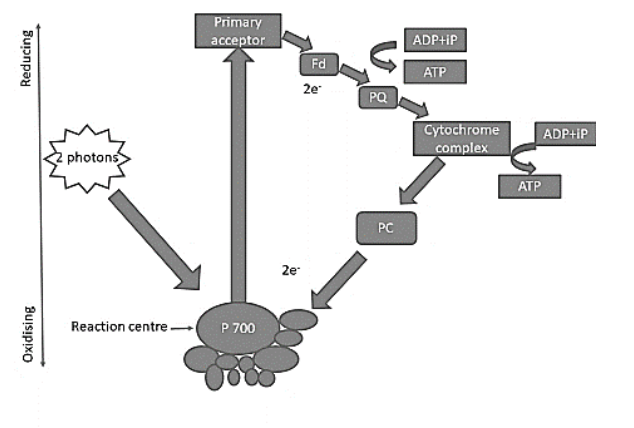
Define photophosphorylation and describe cyclic phosphorylation.
Answer
555.9k+ views
Hint: In the word, photophosphorylation - Photo means light and phosphorylation is the addition of a phosphoryl group to a molecule. Cyclic phosphorylation is termed due to the movement of electrons in a cyclic manner.
Complete answer:
As understood from the etymology, photophosphorylation is a process in which plants convert adenosine diphosphate (\[ADP\]) to adenosine triphosphate (\[ATP\]) through phosphorylation using sunlight as an energy source. The \[ATP\] produced is the source for energy for the cells. This phosphorylation is of two types: cyclic and non-cyclic photophosphorylation.
Cyclic photophosphorylation, occurring on the stroma lamellae or fret channels, is initiated by the high-energy electron produced by chlorophyll A in \[p700\] of photosystem \[1\] (PS \[1\]) through sunlight. The electron produced activates a series of events starting from the primary acceptor to ferredoxin to plastoquinone then to cytochrome \[b6f\] to plastocyanin and finally goes back to PS \[1\]. During this excitation, two \[ATP\] molecules are released. The proton motive force generates a concentration gradient which can be used during chemiosmosis.

Note: Cyclic and non-cyclic photophosphorylation are entirely different. In cyclic photophosphorylation, only PS \[1\] is involved whereas in non-cyclic both PS \[1\] and PS \[2\] are involved. Neither oxygen nor \[NADPH\] is released during cyclic photophosphorylation but both are released during non-cyclic photophosphorylation.
Similarly, cyclic photophosphorylation also occurs in photosynthetic bacteria to meet their energy needs. Bacteria have only one photosystem \[1\] whose chlorophyll absorbs wavelengths of \[800 - 1000nm\], unlike plants which absorb \[650 - 750nm\]. However, cyanobacteria possesses two photosystems and performs similar to plants. In plants \[H2O\] donates electrons to photophosphorylation. But in bacteria \[H2S\]and other chemical compounds donate electrons to generate energy.
Complete answer:
As understood from the etymology, photophosphorylation is a process in which plants convert adenosine diphosphate (\[ADP\]) to adenosine triphosphate (\[ATP\]) through phosphorylation using sunlight as an energy source. The \[ATP\] produced is the source for energy for the cells. This phosphorylation is of two types: cyclic and non-cyclic photophosphorylation.
Cyclic photophosphorylation, occurring on the stroma lamellae or fret channels, is initiated by the high-energy electron produced by chlorophyll A in \[p700\] of photosystem \[1\] (PS \[1\]) through sunlight. The electron produced activates a series of events starting from the primary acceptor to ferredoxin to plastoquinone then to cytochrome \[b6f\] to plastocyanin and finally goes back to PS \[1\]. During this excitation, two \[ATP\] molecules are released. The proton motive force generates a concentration gradient which can be used during chemiosmosis.

Note: Cyclic and non-cyclic photophosphorylation are entirely different. In cyclic photophosphorylation, only PS \[1\] is involved whereas in non-cyclic both PS \[1\] and PS \[2\] are involved. Neither oxygen nor \[NADPH\] is released during cyclic photophosphorylation but both are released during non-cyclic photophosphorylation.
Similarly, cyclic photophosphorylation also occurs in photosynthetic bacteria to meet their energy needs. Bacteria have only one photosystem \[1\] whose chlorophyll absorbs wavelengths of \[800 - 1000nm\], unlike plants which absorb \[650 - 750nm\]. However, cyanobacteria possesses two photosystems and performs similar to plants. In plants \[H2O\] donates electrons to photophosphorylation. But in bacteria \[H2S\]and other chemical compounds donate electrons to generate energy.
Recently Updated Pages
Master Class 11 Business Studies: Engaging Questions & Answers for Success

Master Class 11 English: Engaging Questions & Answers for Success

Master Class 11 Computer Science: Engaging Questions & Answers for Success

Master Class 11 Social Science: Engaging Questions & Answers for Success

Master Class 11 Maths: Engaging Questions & Answers for Success

Master Class 11 Biology: Engaging Questions & Answers for Success

Trending doubts
One Metric ton is equal to kg A 10000 B 1000 C 100 class 11 physics CBSE

State the laws of reflection of light

Explain zero factorial class 11 maths CBSE

What is 1s 2s 2p 3s 3p class 11 chemistry CBSE

An example of chemosynthetic bacteria is A E coli B class 11 biology CBSE

10 examples of friction in our daily life




